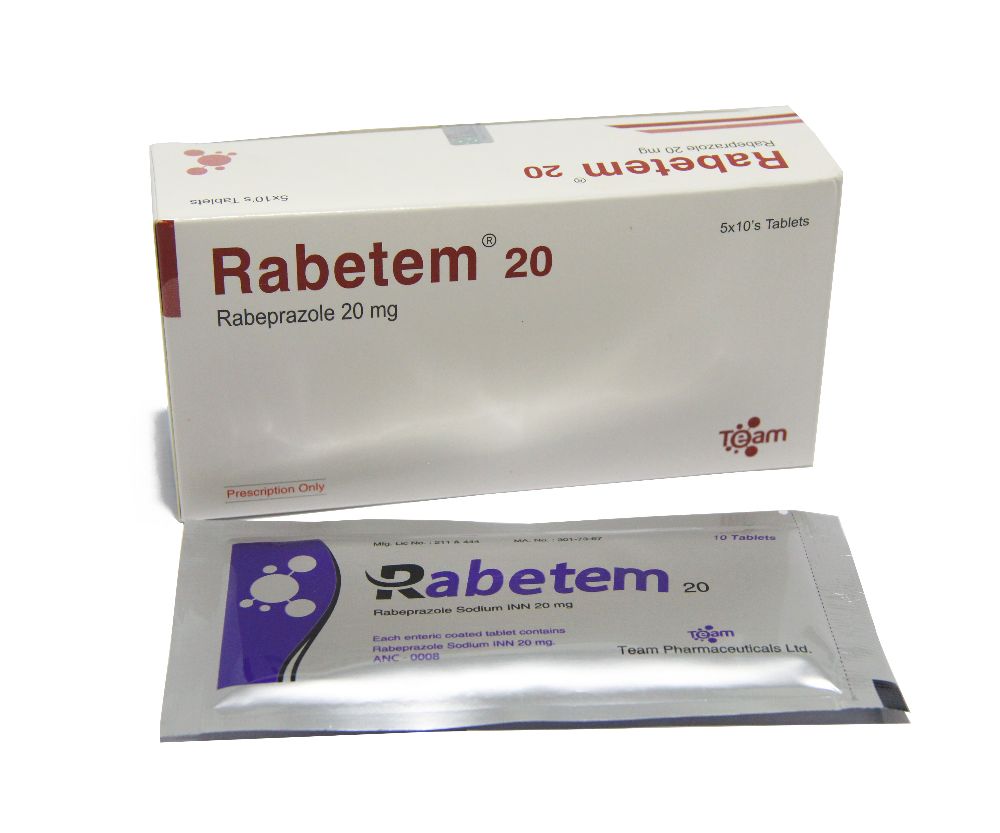
Type:10 Tablets
Generic Name:Rabeprazole
Manufacturer:Team Pharmaceuticals Ltd.
Price:৳45.00
Peptic ulcer disease, H. pylori infection, Gastro-oesophageal reflux disease, Paediatric GERD
Administer with or without meals
Oral Gastro-oesophageal reflux disease Adult: 20 mg daily for 4-8 wk. Maintenance: 10 or 20 mg/day. All doses to be taken once in the morning. Zollinger-Ellison syndrome Adult: Initially, 60 mg once in the morning, adjusted to max dose of 120 mg/day if needed. Daily doses >100 mg should be given in 2 divided doses. Peptic ulcer Adult: 20 mg once in the morning for 4-8 wk (duodenal ulcer) or for 6-12 wk (gastric ulcer). H.pylori infection Adult: 1-wk triple therapy: 20 mg bid combined w/ clarithromycin 500 mg bid and amoxicillin 1 g bid or combined w/ clarithromycin 250 mg bid and metronidazole 400 mg bid. Erosive oesophagitis Adult: 20 mg/day for 4-8 wk. May continue for another 8 wk if healing is incomplete. Maintenance: 10 or 20 mg/day. All doses to be taken once in the morning. Elderly: No dosage adjustment needed. Hepatic impairment: No dosage adjustment needed.
Delayed-release capsule (sprinkles) <1 year: Safety and efficacy not established 1-11 years (<15 kg): 5 mg PO qDay 30 minutes before a meal, for up to 12 weeks; may increase to 10 mg/day if inadequate response 1-11 years (>15 kg): 10 mg PO qDay 30 minutes before a meal, for up to 12 weeks Gastroesophageal Reflux Disease Delayed-release tablet <12 years: Safety and efficacy not established >12 years: 20 mg PO qDay for up to 8 weeks
Renal impairment: No dosage adjustment needed.
Rabeprazole is contraindicated in patients with known hypersensitivity to Rabeprazole, other PPIs or to any component of the formulation.
Rabeprazole is a PPI that suppresses gastric acid secretion by inhibiting H+/K+ ATPase at the secretory surface of the gastric parietal cell.
Gastric malignancy should be ruled out. Severe hepatic impairment. Pregnancy and lactation. Monitoring Parameters Monitor Mg levels prior to initiation and periodically during prolonged use. Lactation Risk Summary Lactation studies have not been conducted to assess presence in human milk, effects on breastfed infant, or effects on milk production; drug is present in rat milk; development and health benefits of breastfeeding should be considered along with mother’s clinical need for therapy and any potential adverse effects on breastfed infant from drug or from underlying maternal condition
1-10% Headache (2-10%),Constipation (2%),Diarrhea (2-5%),Flatulence (3%),Pain (3%),Pharyngitis (3%),Abdominal pain (4%) <1% Agitation,Agranulocytosis,Alopecia,Anemia,Angioedema,Chest pain,Delirium,Erythema,Hypokalemia,Hypomagnesemia,Hyponatremia,Jaundice,Leukocytosis,Leukopenia,Migraine,Osteoporosis related fracture,Rhabdomyolysis,Stevens-Johnson syndrome,Sudden death,Toxic epidermal necrolysis,Abnormal taste
Risk Summary There are no available human data in pregnant women to inform drug associated risk; background risk of major birth defects and miscarriage for indicated populations are unknown; however, background risk in U.S. general population of major birth defects is 2-4% and of miscarriage is 15- 20% of clinically recognized pregnancies; no evidence of adverse developmental effects were seen in animal reproduction studies with rabeprazole administered during organogenesis at 13 and 8 times human area under plasma concentration-time curve (AUC) at recommended dose for GERD, in rats and rabbits, respectively; Changes in bone morphology were observed in offspring of rats treated with oral doses of different PPI through most of pregnancy and lactation; when maternal administration was confined to gestation only, there were no effects on bone physeal morphology in offspring at any age
May decrease serum concentration of ketoconazole, itraconazole and clopidogrel. Increased risk of hypomagnesaemia w/ diuretics and digoxin. May increase prothrombin time and INR of warfarin. May increase plasma concentration of saquinavir and methotrexate. Decreased serum levels w/ sucralfate. Potentially Fatal: May decrease plasma concentrations and pharmacological effects of rilpivirine and atazanavir.